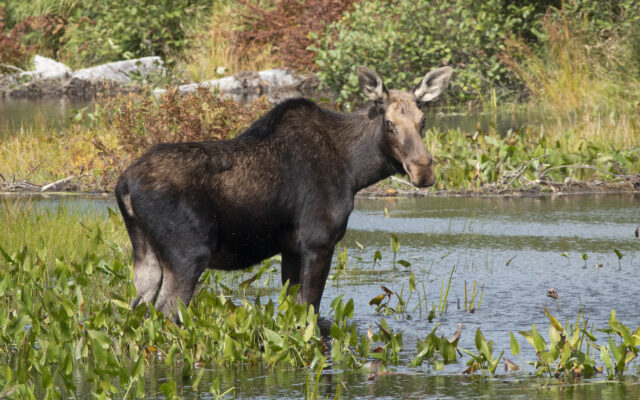
5 of the best places in Maine to see a moose
By Pete Warner, Bangor Daily News Staff
The majestic moose is the animal most often associated with the state of Maine.
Residents and vacationers alike hit the roads all year long in the hope of catching a glimpse of the curious creatures, which can weigh upwards of 1,200 pounds while standing up to 6.5 feet at the shoulder.
While you never really know where or when you might come across a moose, we have put together a list of five areas of Maine where you have a good chance of seeing one.
Most of the state’s moose population is concentrated in the northern and western regions, where miles of unspoiled forests, land harvested for timber and cooling ponds provide excellent habitat.
Of course, there are no guarantees. During the summer, and even in the late spring and early fall, warm temperatures may keep moose in and around water or in the shade of the trees, where they can stay cool.
Keeping in mind that moose roam free in the forest — and aren’t just hanging out at the DOT facility in Shirley every night at dusk — here are some places where you might find one.
Moose are plentiful in the area surrounding Moosehead Lake, which includes Route 11/6 to the west, all the way to Jackman, and the Lily Bay Road along the eastern shore, which ventures past Kokadjo and First Roach Pond. Moose safaris, which usually are slightly off the beaten path, are a big draw in that area.
Slightly to the north, travelers along the Golden Road from the Quebec border all the way to Millinocket also will be motoring through some of the state’s best moose habitat. You’ll be sharing the gravel road with logging trucks, so use caution. If you prefer to do your moose watching on foot, visitors to nearby Baxter State Park often are treated to sightings as they hike, paddle, swim, ski and snowmobile through the area.
Aroostook County also is home to lots of moose and the Route 11 corridor from northernmost Penobscot County in Patten all the way to Fort Kent should provide ample opportunities to see them. Again, moose can appear suddenly out of the tree line, so keep your eyes peeled, particularly at night.
If you would prefer something farther downstate, both the area near Sugarloaf Mountain in Kingfield, accessed by Route 27, and the Rangeley Lakes region, where Routes 4 and 17 are the main roads, are located in some mountainous, wooded, moosey terrain.
Moose searchers might also consider a trip up Route 201, through the Kennebec River valley, from Skowhegan up through Bingham and The Forks to Jackman.
During the warmer times of the year, the early morning and late evening are probably the best times to stake out a known moose spot.
And travelers should take care all year to look for moose in roadways since collisions can be deadly.
If you’re willing to do a bit of extra work, the moose mating period extends roughly from mid-September through the middle of October. Pick a week, preferably when hunters aren’t also in the woods (prior to Sept. 26 and between Oct. 2-9), and find a quiet place where moose might be hanging out.
Check out this BDN video (https://www.bangordailynews.com/2021/09/29/outdoors/the-quick-and-dirty-guide-on-how-to-call-a-moose/) that shows the kinds of calls that could elicit a response from a moose and get one to show itself.